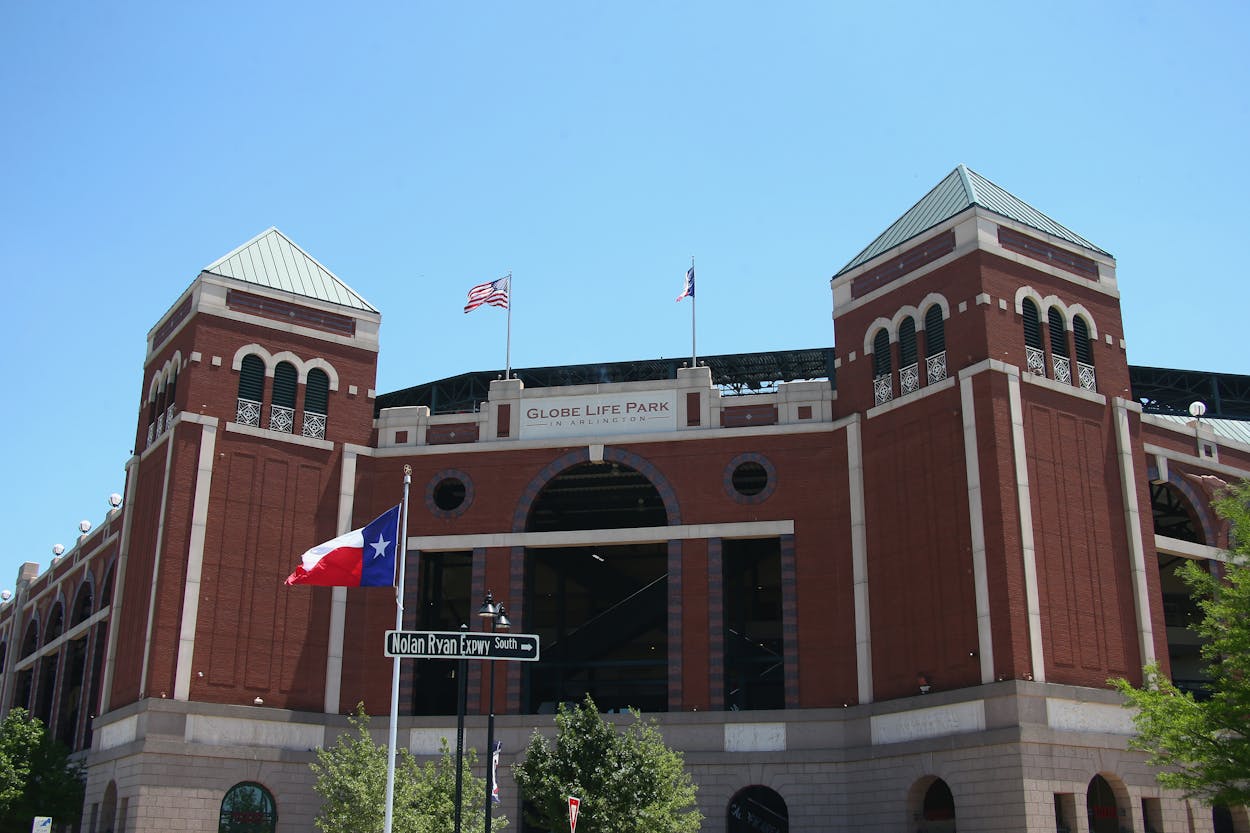As the Texas Rangers claimed the AL West last fall, Major League Baseball printed celebratory T-shirts boasting the accomplishment: “The West Is Ours,” it read, over a backdrop that included, er, the Dallas skyline. That was a problem, because the Rangers play in Arlington, twenty whole miles away. Fans revolted, and the stadium stopped selling the shirts for fear of offending Arlingtonians who resented being folded into the identity of Dallas. The rivalry between Arlington and Dallas may be largely one-sided—more Pawnee/Eagleton than Springfield/Shelbyville—but it is definitely real.
Dallas looms large as a villain in the current politicking around the Rangers. The team has been seeking a massive stadium bond, asking taxpayers in Arlington for $500 million—though, when all is said and done, it may end up being closer to $800 million—for money to build a new stadium to replace Globe Life Park, which was built in 1994.
Globe Life isn’t exactly crumbling—the argument against the park tends to revolve around the fact that there’s no roof, so the stadium gets hot (which means that the other villain in this narrative is the sun), and thus is unappealing for fans and a competitive disadvantage for the Rangers.
Whatever it is that’s keeping people away from Globe Life Park, though, it’s definitely working. Last year, in the midst of a playoff push, the Rangers averaged 30,000 fans per game. Those are pathetic numbers for a contender, but it was easy to explain them away—nobody expected the Rangers to be good, so season ticket sales were depressed. That number did jump a bit as the Rangers repeated the performance, with an average attendance of over 33,000 per game. But it’s worth noting that it is still the lowest attendance figure the Rangers have ever had in a season following a playoff run.
Last year, when speculating about whatever keeps people from going to see the team in Arlington, D Magazine argued that the Rangers should move to Dallas. That threat is a big part of the stadium bond push—the PAC urging voters to approve the bond is called “Keep The Rangers,” and on Tuesday, the Dallas Morning News laid out the scenario that could see the team pick up stakes and move twenty miles east.
Arlington Mayor Jeff Williams said it’s private money, not public, that’s the real threat. He cited private contributions to the Dallas Arts District, Klyde Warren Park and Calatrava bridges. He could have reeled off more, including the Perot Museum, the Meyerson and the Bush Presidential Center.
Private donors were crucial for these initiatives. For the AT&T Performing Arts Center, private money funded over 95 percent of the $360 million cost. And 134 individuals, families, foundations and companies gave at least $1 million.
It’s “the combination of the public-private sector” that’s so powerful, Williams said. “For two years, I was being told that Dallas was gonna be taking the Rangers, [that] it’s a done deal.
“It is amazing what cities can do if they want to,” he added. “I never want to underestimate the ability of Dallas or our other communities.”
The Rangers history in Arlington is deep. The city only landed the Cowboys in 2009, the Rangers have called Arlington home since 1972, when the Washington Senators moved to Texas and rebranded themselves. And Dallas has been covetous ever since: In 1989, when the Rangers ownership changed hands, Dallas leaders pushed for the team. Former Arlington Mayor Richard Greene recalled the situation well in a column for the Fort Worth Star-Telegram earlier this summer, warning Arlington voters that the team could end up with the Dallas skyline behind them in more than just a t-shirt in the near future.
That possibility—not just of the Rangers moving, but moving to a neighboring city that voters tend to resent—is key to understanding the stadium bond push. Dallas might be able to come up with the money, or it might not. Private investment is a possibility, but it’s also tough to imagine Dallas’ billionaires deciding to just give money to the Rangers for a stadium, even if it could impact their bottom line in the long run. Public money is a much longer shot—Dallas couldn’t come up with $320 million in taxpayer dollars for the Cowboys in 2004, so it’s tough to imagine the city would decide to spend more than that on baseball. But the mere whisper of a move to Dallas is enough to get the idea of building a new stadium in the exact same spot as a stadium that opened just twenty-two years ago taken very seriously.
For their part, the Rangers are aware of those local tensions, and seem quite content to exploit them. The t-shirts last year were created by Major League Baseball, but if the Rangers had put the skyline in the background to exploit the fear of Dallas, it’d have been about as masterful a troll job as what they told the Dallas Morning News editorial board this summer:
At the editorial board meeting, an executive was asked if there was really a chance of the team leaving.
“To leave North Texas—no,” said Rob Matwick, who oversees business operations.
How about leaving Arlington?
“We have a lease through 2024,” Matwick said.
That’s a pretty masterful attempt at playing on those local anxieties.








